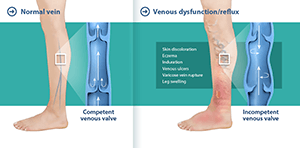Varicose Veins / Venous Ablations

Varicose veins occur when weak veins near the surface of the leg stretch, bulge, & twist. Varicose veins can be visible through the skin or bulging from deep under your skin.
If left untreated, varicose veins may cause:
- Fatigue
- Localized Pain
- Swollen Legs & Ankles
- Scaly, Dry Skin
- Leg sores
According to the American College of Phlebology more advanced medical problems can include hyperpigmentation, lipodermosclerosis, venous leg ulcers, spontaneous bleeding, superficial thrombophlebitis, and a potentially life-threatening condition called deep vein thrombosis.
How does Venous Ablation work?
Varicose vein ablation destroys varicose veins with bursts of radiofrequency or laser energy. Typically, patients experience little to no pain, leaves no scarring, & has a strong history success alleviating varicose veins.
When is Venous Ablation indicated?
May be indicated for patients who:
- Have chronic venous insufficiency
- Suffer from skin problems on the legs
- Wish to improve the appearance of varicose veins
IF varicose vein ablation is used cosmetically, it may not be covered by your health insurance.
How do I prepare for the procedure?
A few days before the procedure, pre-procedure tests may be performed to ensure that it is safe to perform the procedure. You may need to discontinue certain medications before the procedure. Your healthcare team will provide specific instructions to help you prepare for the procedure.
What to Expect on Procedure Day?
The goals of treatment are to reduce symptoms and reduce the risk of complications from venous disease, including blood clots. Each patient is evaluated, and treatment will be individualized for the patient’s circumstances.
Varicose vein ablation is performed on an outpatient basis under local anesthesia.
- A duplex ultrasound to the leg veins will be conducted just prior to starting the procedure for placement purposes. Several marking will be placed on your skin to help guide the procedure.
- A catheter will be inserted through a small nick in the skin above the vein which allows the catheter to be placed at the end of a particular vein.
- A radiofrequency generator or laser will pulse through the catheter as the provider slowly retract the catheter.
The heat destroys the tissue along the length of the vein. This process causes the vein to collapse & is eventually reabsorbed by the body.
*Occasionally, you may brief pain if the radiofrequency catheter or laser heats tissue near a nerve. However, this pain will disappear once the provider moves the catheter.*
In all, this procedure should take approximately 1 hour to 3 hours & you may experience relief immediately. Follow up treatments may be required.
Can I prevent Varicose veins?
The following lifestyle changes may prevent varicose veins:
- Avoid crossing your legs at the knees when sitting
- Refrain from wearing high heels
- Avoid clothing that is tight around the groin or calf
- Elevate the legs or walk around frequently during the day



